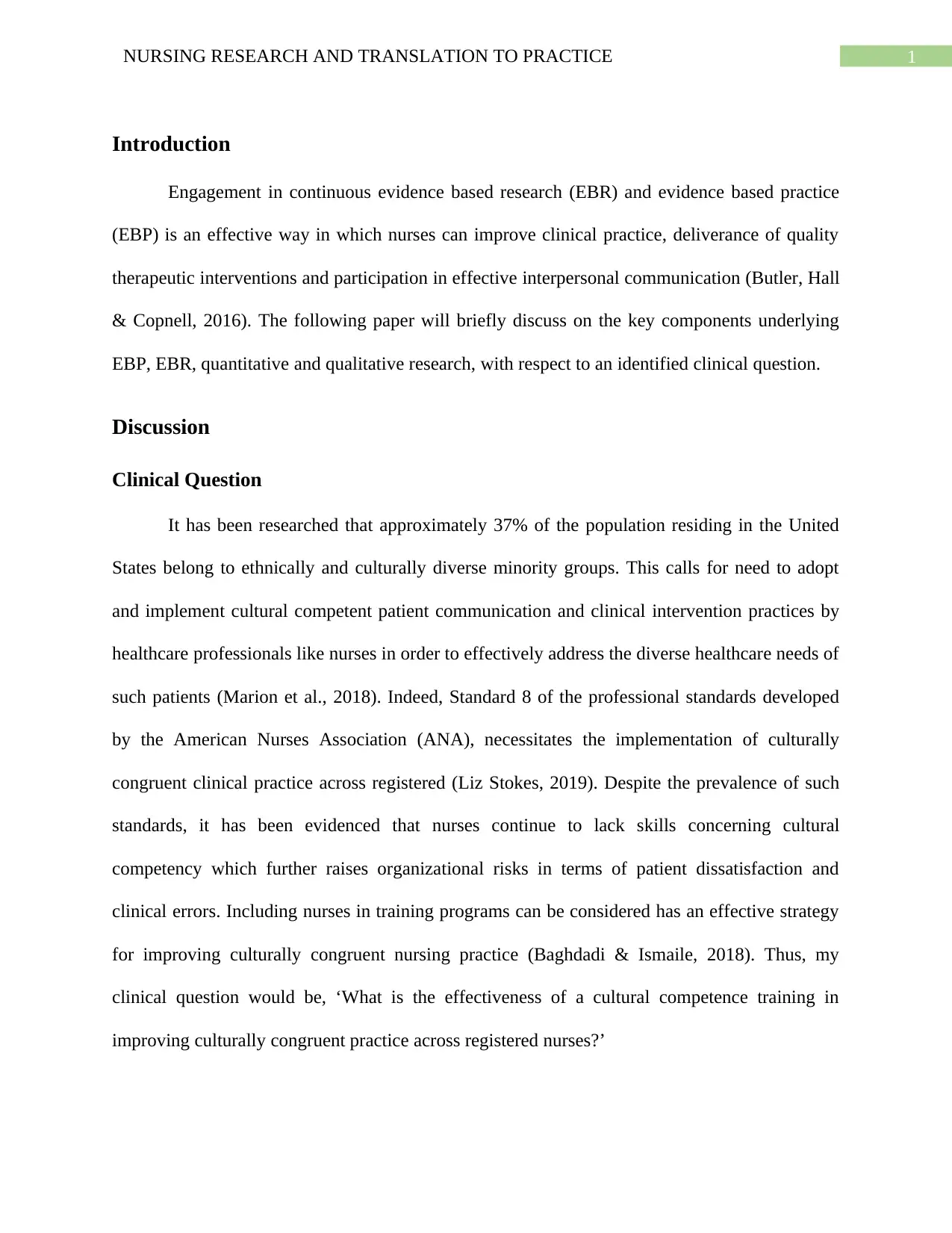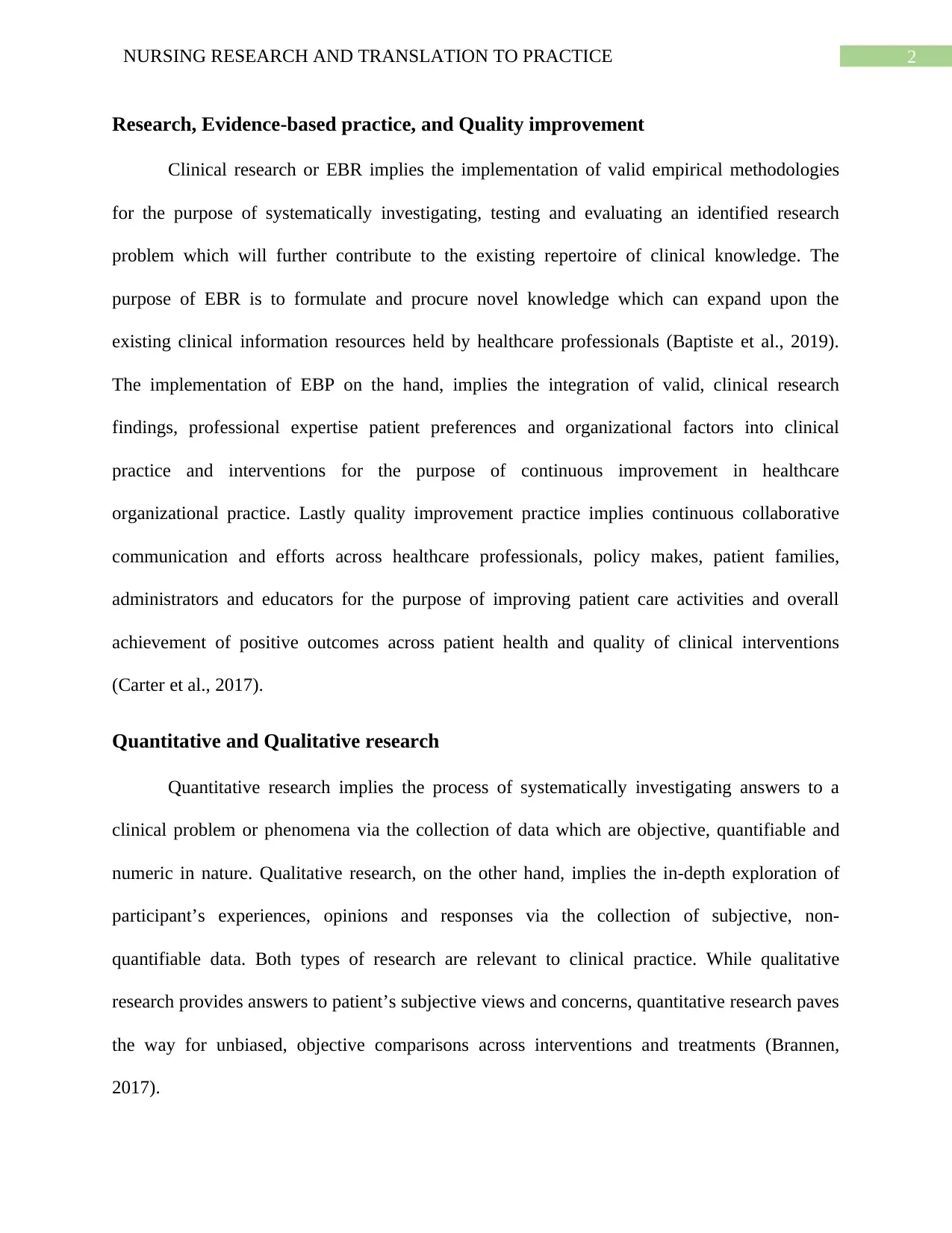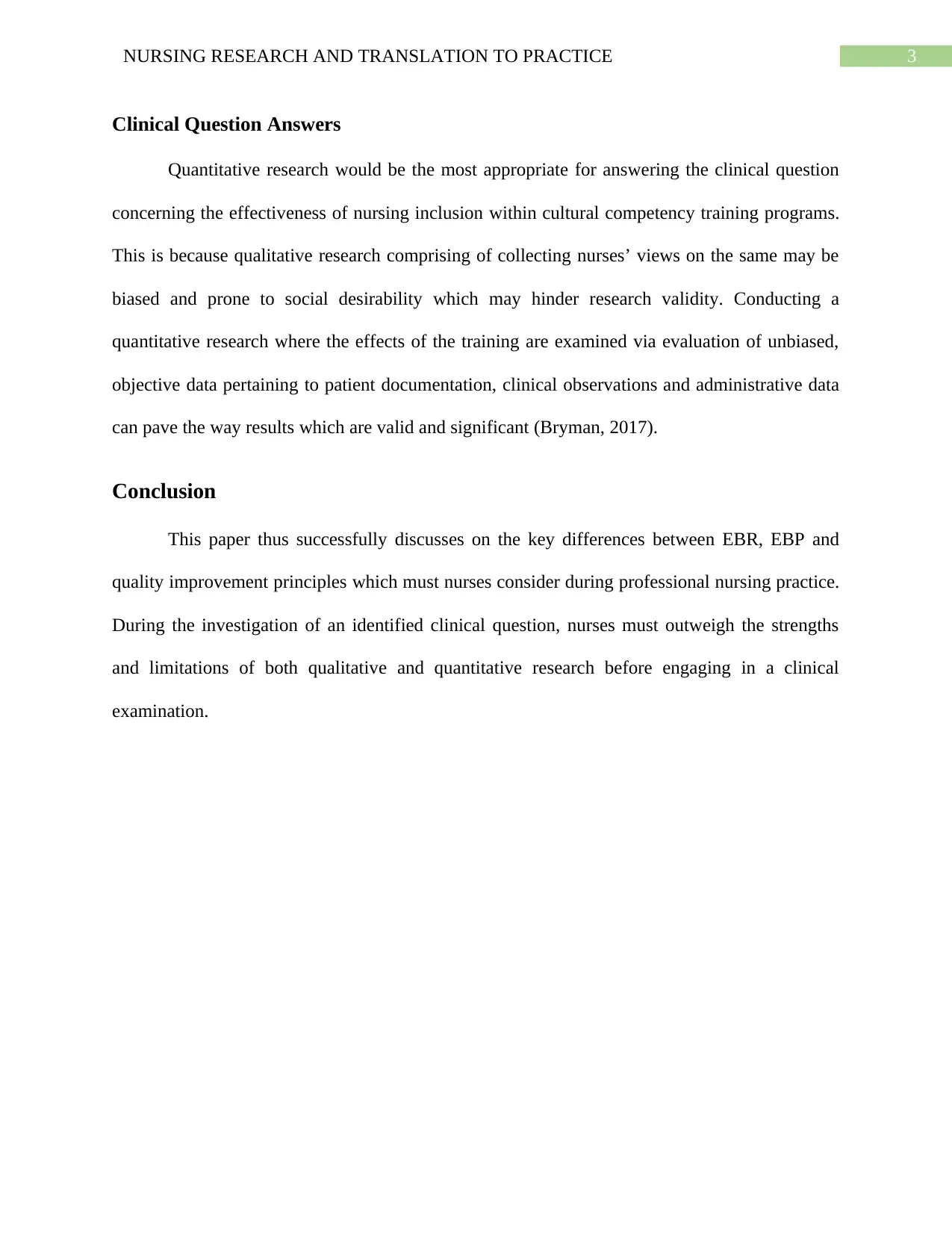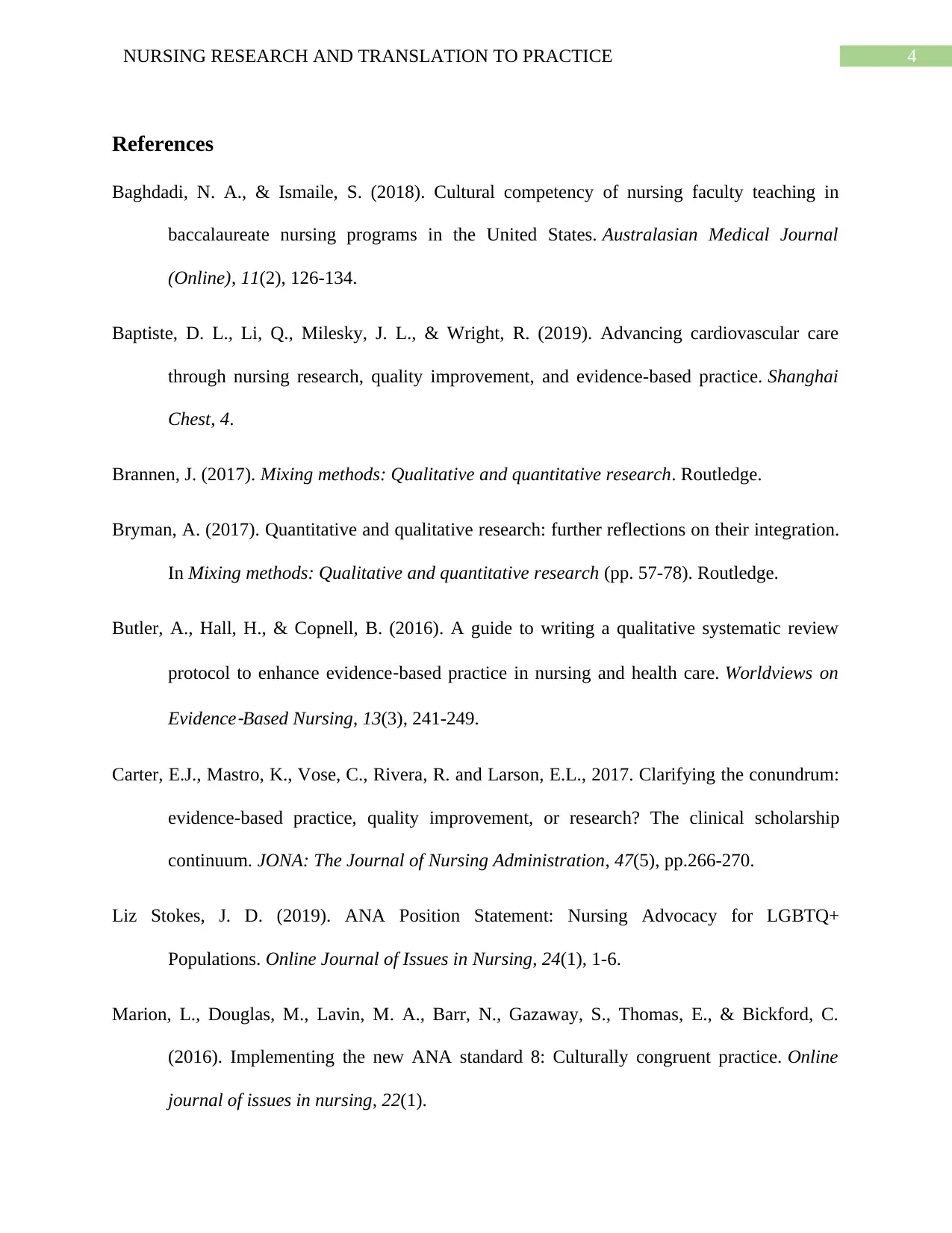Nursing Research and Translation to Practice: Clinical Question
VerifiedAdded on 2022/08/25
|5
|1076
|15
Report
AI Summary
This report delves into the crucial aspects of nursing research and its translation into practice, emphasizing evidence-based practice (EBP) and the significance of cultural competency in healthcare. The report addresses a clinical question concerning the effectiveness of cultural competency training for registered nurses in improving culturally congruent practice. It explores the differences between clinical research (EBR), EBP, and quality improvement, highlighting the relevance of both quantitative and qualitative research methodologies in addressing clinical issues. The report argues that quantitative research is most suitable for evaluating the effectiveness of training programs, as it provides objective data. It concludes by emphasizing the importance of considering both research types when examining clinical questions and integrating research findings into nursing practice to enhance patient care and outcomes.

Running head: NURSING RESEARCH AND TRANSLATION TO PRACTICE
NURSING RESEARCH AND TRANSLATION TO PRACTICE
Name of the Student:
Name of the University:
Author note:
NURSING RESEARCH AND TRANSLATION TO PRACTICE
Name of the Student:
Name of the University:
Author note:
Paraphrase This Document
Need a fresh take? Get an instant paraphrase of this document with our AI Paraphraser

1NURSING RESEARCH AND TRANSLATION TO PRACTICE
Introduction
Engagement in continuous evidence based research (EBR) and evidence based practice
(EBP) is an effective way in which nurses can improve clinical practice, deliverance of quality
therapeutic interventions and participation in effective interpersonal communication (Butler, Hall
& Copnell, 2016). The following paper will briefly discuss on the key components underlying
EBP, EBR, quantitative and qualitative research, with respect to an identified clinical question.
Discussion
Clinical Question
It has been researched that approximately 37% of the population residing in the United
States belong to ethnically and culturally diverse minority groups. This calls for need to adopt
and implement cultural competent patient communication and clinical intervention practices by
healthcare professionals like nurses in order to effectively address the diverse healthcare needs of
such patients (Marion et al., 2018). Indeed, Standard 8 of the professional standards developed
by the American Nurses Association (ANA), necessitates the implementation of culturally
congruent clinical practice across registered (Liz Stokes, 2019). Despite the prevalence of such
standards, it has been evidenced that nurses continue to lack skills concerning cultural
competency which further raises organizational risks in terms of patient dissatisfaction and
clinical errors. Including nurses in training programs can be considered has an effective strategy
for improving culturally congruent nursing practice (Baghdadi & Ismaile, 2018). Thus, my
clinical question would be, ‘What is the effectiveness of a cultural competence training in
improving culturally congruent practice across registered nurses?’
Introduction
Engagement in continuous evidence based research (EBR) and evidence based practice
(EBP) is an effective way in which nurses can improve clinical practice, deliverance of quality
therapeutic interventions and participation in effective interpersonal communication (Butler, Hall
& Copnell, 2016). The following paper will briefly discuss on the key components underlying
EBP, EBR, quantitative and qualitative research, with respect to an identified clinical question.
Discussion
Clinical Question
It has been researched that approximately 37% of the population residing in the United
States belong to ethnically and culturally diverse minority groups. This calls for need to adopt
and implement cultural competent patient communication and clinical intervention practices by
healthcare professionals like nurses in order to effectively address the diverse healthcare needs of
such patients (Marion et al., 2018). Indeed, Standard 8 of the professional standards developed
by the American Nurses Association (ANA), necessitates the implementation of culturally
congruent clinical practice across registered (Liz Stokes, 2019). Despite the prevalence of such
standards, it has been evidenced that nurses continue to lack skills concerning cultural
competency which further raises organizational risks in terms of patient dissatisfaction and
clinical errors. Including nurses in training programs can be considered has an effective strategy
for improving culturally congruent nursing practice (Baghdadi & Ismaile, 2018). Thus, my
clinical question would be, ‘What is the effectiveness of a cultural competence training in
improving culturally congruent practice across registered nurses?’

2NURSING RESEARCH AND TRANSLATION TO PRACTICE
Research, Evidence-based practice, and Quality improvement
Clinical research or EBR implies the implementation of valid empirical methodologies
for the purpose of systematically investigating, testing and evaluating an identified research
problem which will further contribute to the existing repertoire of clinical knowledge. The
purpose of EBR is to formulate and procure novel knowledge which can expand upon the
existing clinical information resources held by healthcare professionals (Baptiste et al., 2019).
The implementation of EBP on the hand, implies the integration of valid, clinical research
findings, professional expertise patient preferences and organizational factors into clinical
practice and interventions for the purpose of continuous improvement in healthcare
organizational practice. Lastly quality improvement practice implies continuous collaborative
communication and efforts across healthcare professionals, policy makes, patient families,
administrators and educators for the purpose of improving patient care activities and overall
achievement of positive outcomes across patient health and quality of clinical interventions
(Carter et al., 2017).
Quantitative and Qualitative research
Quantitative research implies the process of systematically investigating answers to a
clinical problem or phenomena via the collection of data which are objective, quantifiable and
numeric in nature. Qualitative research, on the other hand, implies the in-depth exploration of
participant’s experiences, opinions and responses via the collection of subjective, non-
quantifiable data. Both types of research are relevant to clinical practice. While qualitative
research provides answers to patient’s subjective views and concerns, quantitative research paves
the way for unbiased, objective comparisons across interventions and treatments (Brannen,
2017).
Research, Evidence-based practice, and Quality improvement
Clinical research or EBR implies the implementation of valid empirical methodologies
for the purpose of systematically investigating, testing and evaluating an identified research
problem which will further contribute to the existing repertoire of clinical knowledge. The
purpose of EBR is to formulate and procure novel knowledge which can expand upon the
existing clinical information resources held by healthcare professionals (Baptiste et al., 2019).
The implementation of EBP on the hand, implies the integration of valid, clinical research
findings, professional expertise patient preferences and organizational factors into clinical
practice and interventions for the purpose of continuous improvement in healthcare
organizational practice. Lastly quality improvement practice implies continuous collaborative
communication and efforts across healthcare professionals, policy makes, patient families,
administrators and educators for the purpose of improving patient care activities and overall
achievement of positive outcomes across patient health and quality of clinical interventions
(Carter et al., 2017).
Quantitative and Qualitative research
Quantitative research implies the process of systematically investigating answers to a
clinical problem or phenomena via the collection of data which are objective, quantifiable and
numeric in nature. Qualitative research, on the other hand, implies the in-depth exploration of
participant’s experiences, opinions and responses via the collection of subjective, non-
quantifiable data. Both types of research are relevant to clinical practice. While qualitative
research provides answers to patient’s subjective views and concerns, quantitative research paves
the way for unbiased, objective comparisons across interventions and treatments (Brannen,
2017).
⊘ This is a preview!⊘
Do you want full access?
Subscribe today to unlock all pages.

Trusted by 1+ million students worldwide

3NURSING RESEARCH AND TRANSLATION TO PRACTICE
Clinical Question Answers
Quantitative research would be the most appropriate for answering the clinical question
concerning the effectiveness of nursing inclusion within cultural competency training programs.
This is because qualitative research comprising of collecting nurses’ views on the same may be
biased and prone to social desirability which may hinder research validity. Conducting a
quantitative research where the effects of the training are examined via evaluation of unbiased,
objective data pertaining to patient documentation, clinical observations and administrative data
can pave the way results which are valid and significant (Bryman, 2017).
Conclusion
This paper thus successfully discusses on the key differences between EBR, EBP and
quality improvement principles which must nurses consider during professional nursing practice.
During the investigation of an identified clinical question, nurses must outweigh the strengths
and limitations of both qualitative and quantitative research before engaging in a clinical
examination.
Clinical Question Answers
Quantitative research would be the most appropriate for answering the clinical question
concerning the effectiveness of nursing inclusion within cultural competency training programs.
This is because qualitative research comprising of collecting nurses’ views on the same may be
biased and prone to social desirability which may hinder research validity. Conducting a
quantitative research where the effects of the training are examined via evaluation of unbiased,
objective data pertaining to patient documentation, clinical observations and administrative data
can pave the way results which are valid and significant (Bryman, 2017).
Conclusion
This paper thus successfully discusses on the key differences between EBR, EBP and
quality improvement principles which must nurses consider during professional nursing practice.
During the investigation of an identified clinical question, nurses must outweigh the strengths
and limitations of both qualitative and quantitative research before engaging in a clinical
examination.
Paraphrase This Document
Need a fresh take? Get an instant paraphrase of this document with our AI Paraphraser

4NURSING RESEARCH AND TRANSLATION TO PRACTICE
References
Baghdadi, N. A., & Ismaile, S. (2018). Cultural competency of nursing faculty teaching in
baccalaureate nursing programs in the United States. Australasian Medical Journal
(Online), 11(2), 126-134.
Baptiste, D. L., Li, Q., Milesky, J. L., & Wright, R. (2019). Advancing cardiovascular care
through nursing research, quality improvement, and evidence-based practice. Shanghai
Chest, 4.
Brannen, J. (2017). Mixing methods: Qualitative and quantitative research. Routledge.
Bryman, A. (2017). Quantitative and qualitative research: further reflections on their integration.
In Mixing methods: Qualitative and quantitative research (pp. 57-78). Routledge.
Butler, A., Hall, H., & Copnell, B. (2016). A guide to writing a qualitative systematic review
protocol to enhance evidence‐based practice in nursing and health care. Worldviews on
Evidence
‐Based Nursing, 13(3), 241-249.
Carter, E.J., Mastro, K., Vose, C., Rivera, R. and Larson, E.L., 2017. Clarifying the conundrum:
evidence-based practice, quality improvement, or research? The clinical scholarship
continuum. JONA: The Journal of Nursing Administration, 47(5), pp.266-270.
Liz Stokes, J. D. (2019). ANA Position Statement: Nursing Advocacy for LGBTQ+
Populations. Online Journal of Issues in Nursing, 24(1), 1-6.
Marion, L., Douglas, M., Lavin, M. A., Barr, N., Gazaway, S., Thomas, E., & Bickford, C.
(2016). Implementing the new ANA standard 8: Culturally congruent practice. Online
journal of issues in nursing, 22(1).
References
Baghdadi, N. A., & Ismaile, S. (2018). Cultural competency of nursing faculty teaching in
baccalaureate nursing programs in the United States. Australasian Medical Journal
(Online), 11(2), 126-134.
Baptiste, D. L., Li, Q., Milesky, J. L., & Wright, R. (2019). Advancing cardiovascular care
through nursing research, quality improvement, and evidence-based practice. Shanghai
Chest, 4.
Brannen, J. (2017). Mixing methods: Qualitative and quantitative research. Routledge.
Bryman, A. (2017). Quantitative and qualitative research: further reflections on their integration.
In Mixing methods: Qualitative and quantitative research (pp. 57-78). Routledge.
Butler, A., Hall, H., & Copnell, B. (2016). A guide to writing a qualitative systematic review
protocol to enhance evidence‐based practice in nursing and health care. Worldviews on
Evidence
‐Based Nursing, 13(3), 241-249.
Carter, E.J., Mastro, K., Vose, C., Rivera, R. and Larson, E.L., 2017. Clarifying the conundrum:
evidence-based practice, quality improvement, or research? The clinical scholarship
continuum. JONA: The Journal of Nursing Administration, 47(5), pp.266-270.
Liz Stokes, J. D. (2019). ANA Position Statement: Nursing Advocacy for LGBTQ+
Populations. Online Journal of Issues in Nursing, 24(1), 1-6.
Marion, L., Douglas, M., Lavin, M. A., Barr, N., Gazaway, S., Thomas, E., & Bickford, C.
(2016). Implementing the new ANA standard 8: Culturally congruent practice. Online
journal of issues in nursing, 22(1).
1 out of 5
Related Documents
Your All-in-One AI-Powered Toolkit for Academic Success.
+13062052269
info@desklib.com
Available 24*7 on WhatsApp / Email
![[object Object]](/_next/static/media/star-bottom.7253800d.svg)
Unlock your academic potential
Copyright © 2020–2025 A2Z Services. All Rights Reserved. Developed and managed by ZUCOL.





